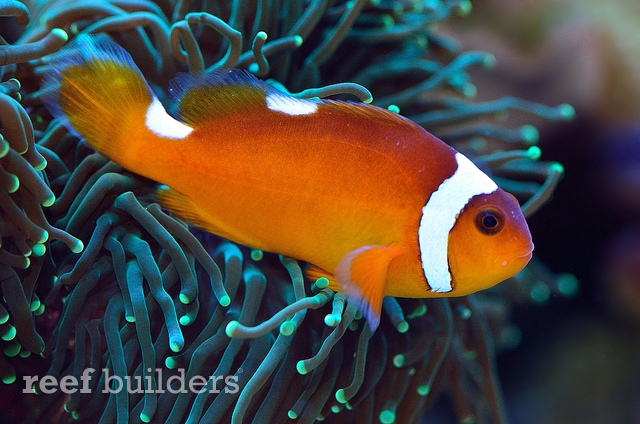Clownfishes are pretty promiscuous as far as fishes go, and many are capable of forming hybrids. There are only two genera of anemone fish, with the monotypic Premnas playing host to the pugnacious maroon clownfish, and the rest being placed in Amphiprion. Many examples of interspecific hybrids have been documented in the wild, as well as “man-made” ones in aquaculture facilities. Intergeneric hybrids between Premnas and Amphiprion are also not uncommon, and are occasionally seen.

Amphiprion “thiellei” is a naturally occurring hybrid between two species in the genus Amphiprion. A. ocellaris x A. sandaracinos are the usual suspects to produce such an offspring, and in places where both species are sympatric, these hybrids are occasionally found. There are photographic evidence of A. thiellei in the wild, and they’re mostly females with smaller A. ocellaris serving as subordinate males.
In the trade, A. thiellei is rare but shows up from time to time from Indonesia. Specimens are usually burnt orange with a full head stripe that may or may not be connected at the top via a bonnet. The subsequent second and third stripes are usually reduced to a short stump. We have seen specimens of A. thiellei with a more peachy hue and clear tails, which may suggest that other members of the skunk complex can also cross with A. ocellaris.

If it is possible, then the “thiellei type” hybrids may not be exclusively reserved for A. ocellaris x A. sandaracinos, and A. ocellaris may hybridise with other sympatric members of the “skunk complex” resulting in hybrids that look similar to the “thiellei type” template. However very little evidence and definite analysis have been proven and so these are all suspicions.
The photo above taken from a video still shows the “peachy clear tailed thiellei” type hybrid that we mentioned just before. A quick consult with various clownfish authorities such as Matthew Pederson and Yuri Barros raised suspicions that A. perideraion, A. akallopisos or even A. frenatus could be in the mix.

Amphiprion thiellei is an Asiatic species occurring along the borders of the Sunda shelf. On the other side, in the Australian Sahul shelf, a similar hybrid involving the skunk complex yet again is also present. A. ocellaris is replaced by A. chrysopterus and hybridises with A. sandaracinos to give Amphiprion leucokranos, a superficially similar looking hybrid to A. thiellei. The geographic occurrence of both hybrid clownfish means that they don’t usually overlap in range, and come from different places.

This raises a flag in hybrid documentation. A. leucokranos is not usually found in the Asiatic Sundanian range, but very similar looking specimens have been collected out of Java, Indonesia. In the usual range of A. leucokranos, for example in Solomon Island, the parent species are A. sandaracinos and A. chrysopterus.
The occurrence of A. chrysopterus in Java is sketchy, and hybrids with A. sandaracinos to produce pure true to type “leucokranos” hybrids may be unlikely. It may be possible that substitutions of A. chrysopterus for another member of the same complex could have occurred, and hybrids of those with A. sandaracinos could yield “leucokranos type” hybrids. In this range, namely Java, Amphiprion clarkii is the most plausible replacement for A. chrysopterus.

The photo above shows two very similar looking hybrids of the “leucokranos type” which were collected in Java where A. chrysopterus is not likely to be found. A. clarkii would be the best fit and is quite similar to A. chrysopterus. We spoke to Dustin Dorton of ORA if this paring could be possible and he said it shouldn’t be too farfetched, and entirely possible.
Another curious thing to note with both A. thiellei and A. leucokranos is the overly strong genetic influence of the “skunk complex” parent. Both hybrid types lack the second and third bar, and it is quite apparent that genetic input of A. sandaracinos or any other member of that complex immediately steamrolls all other traits from the three-barred parent.
But enough of our musings, we would like to know how many of you guys personally own either a thiellei or leucokranos clown, and where it came from. If you have one, post a photo comment in our Facebook page under this article link and discuss!
*edited – The leucokranos clowns from “Java” were eventually revealed to be collected out of Iran Jaya, and exported via Java. At this location, A. chrysopterus can be found and so these are true to type “leucokranos” hybrids.



